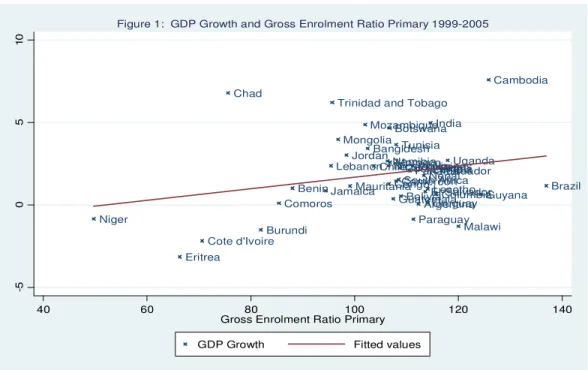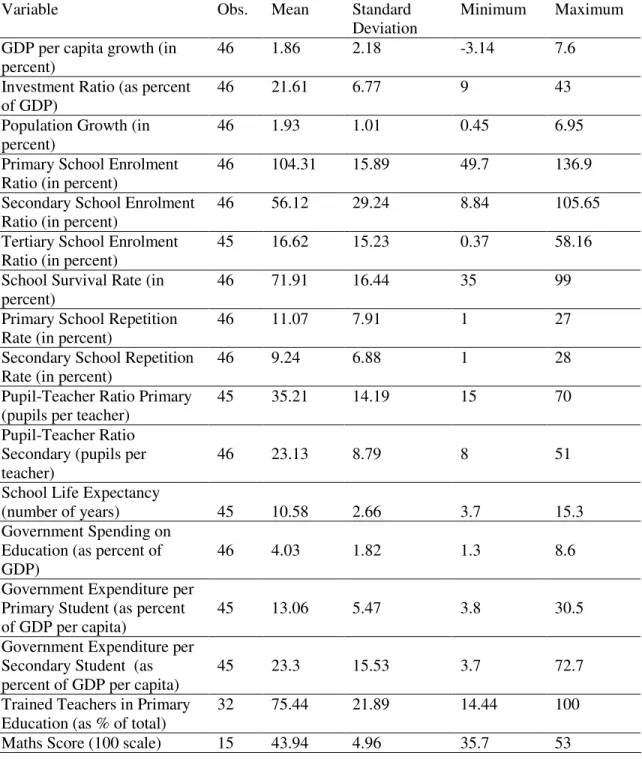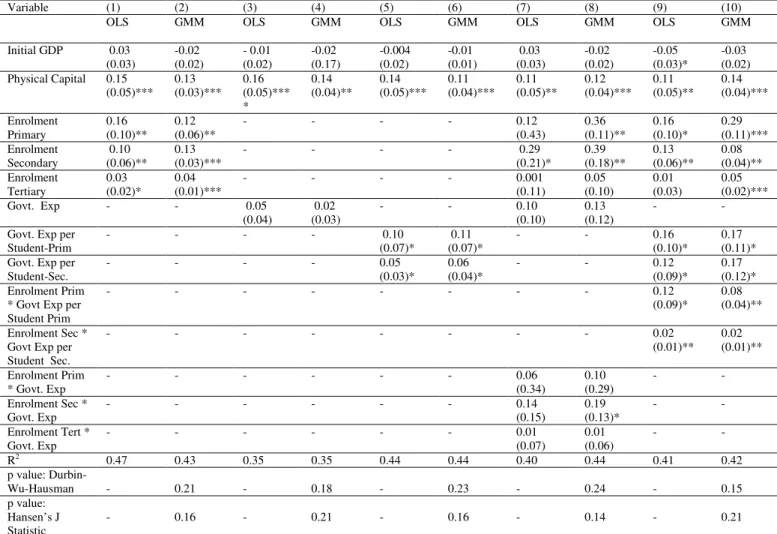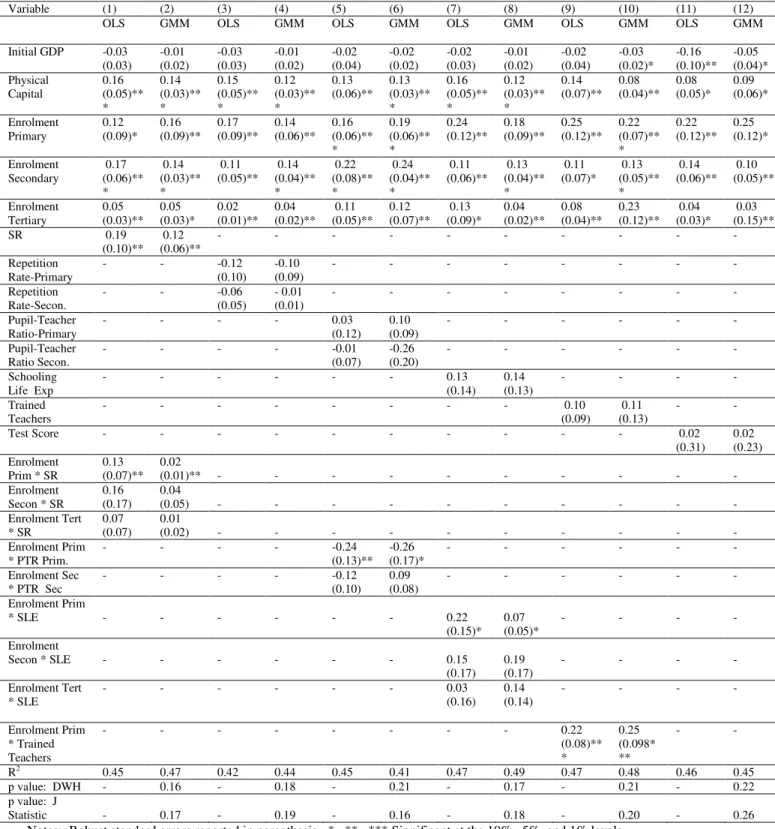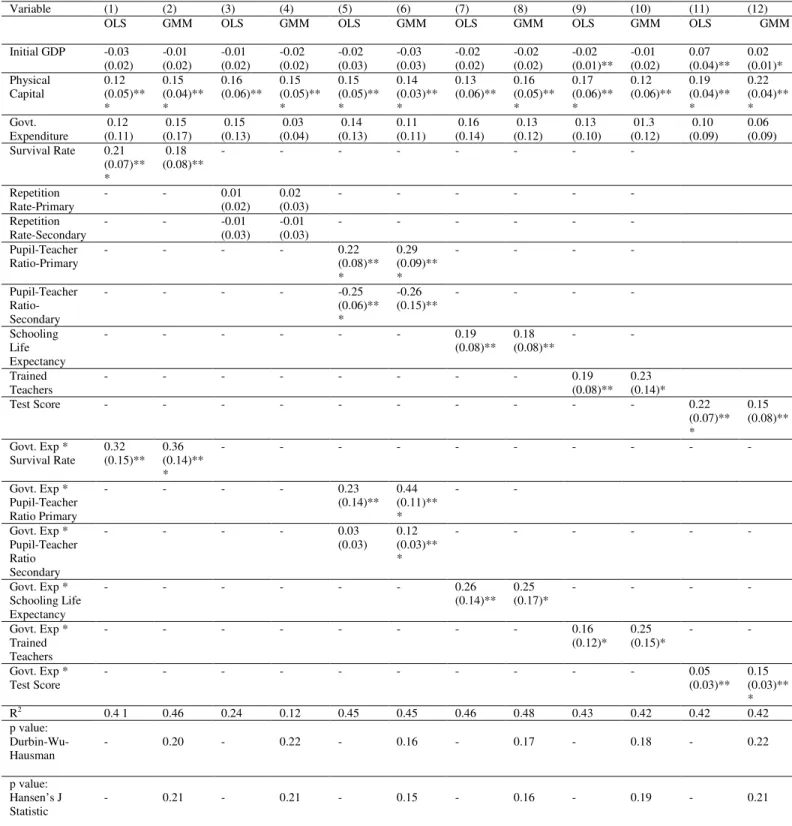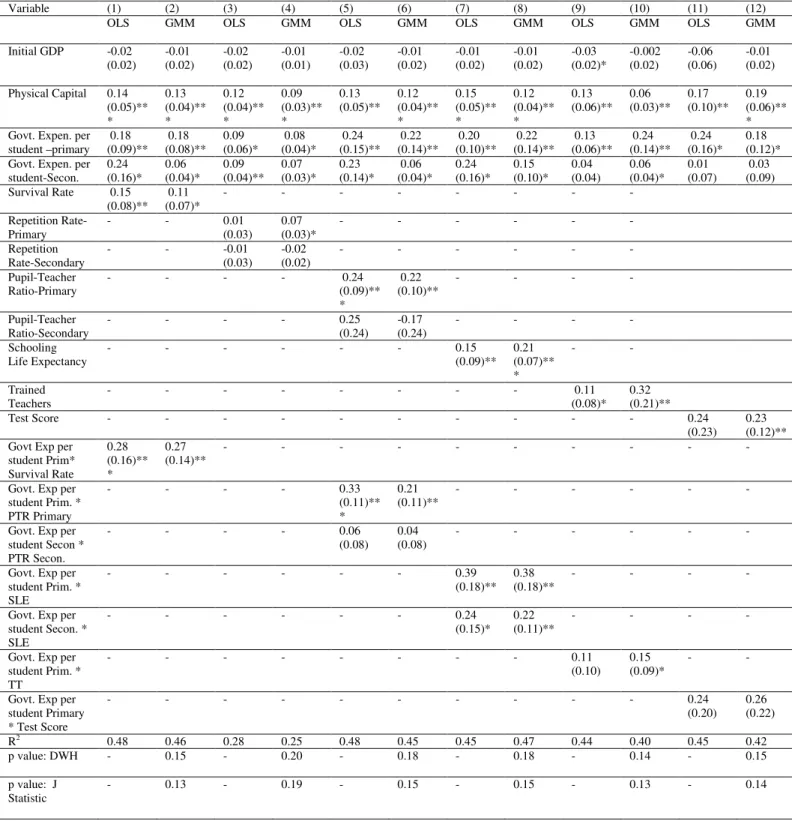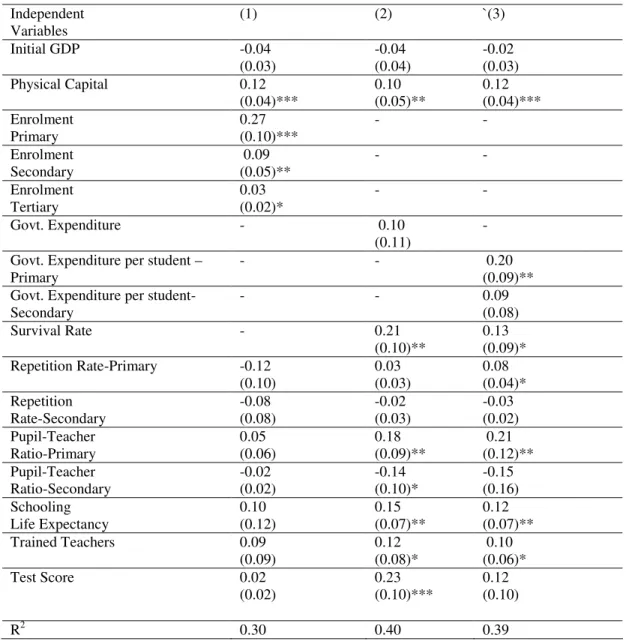University of Wollongong University of Wollongong
Research Online Research Online
Faculty of Commerce - Papers (Archive) Faculty of Business and Law
1-1-2009
The role of education in economic growth The role of education in economic growth
Arusha V. Cooray
University of Wollongong, arusha@uow.edu.au
Follow this and additional works at: https://ro.uow.edu.au/commpapers
Part of the Business Commons, and the Social and Behavioral Sciences Commons Recommended Citation
Recommended Citation
Cooray, Arusha V.: The role of education in economic growth 2009, 1-27.
https://ro.uow.edu.au/commpapers/694
Research Online is the open access institutional repository for the University of Wollongong. For further information contact the UOW Library: research-pubs@uow.edu.au
The role of education in economic growth The role of education in economic growth
Abstract Abstract
This study examines the effect of the quantity and quality of education on economic growth. Using a number of proxy variables for the quantity and quality of education in a cross section of low and medium income countries, this study finds that education quantity when measured by enrolment ratios,
unambiguously influences economic growth. The effect of government expenditure on economic growth is largely indirect through its impact on improved education quality.
Keywords Keywords
role, economic, growth, education Disciplines
Disciplines
Business | Social and Behavioral Sciences Publication Details
Publication Details
Cooray, A. V. (2009). The role of education in economic growth. Proceedings of the 2009 Australian Conference of Economists (pp. 1-27). Adelaide, Australia: South Australian Branch of the Economic Society of Australia.
This conference paper is available at Research Online: https://ro.uow.edu.au/commpapers/694
THE ROLE OF EDUCATION IN ECONOMIC GROWTH
Arusha Cooray*
Corresponding author: Arusha Cooray, School of Economics, University of Wollongong, Northfields Avenue, NSW 2522, Australia, Tel: 61-2-4221-4017; E-mail: arusha@uow.edu.au.
THE ROLE OF EDUCATION IN ECONOMIC GROWTH
Abstract: This study examines the effect of the quantity and quality of education on economic growth. Using a number of proxy variables for the quantity and quality of education in a cross section of low and medium income countries, this study finds that education quantity when measured by enrolment ratios, unambiguously influences economic growth. The effect of government expenditure on economic growth is largely indirect through its impact on improved education quality.
Keywords: Economic Growth, Education Quantity, Enrolment, Government Spending on Education, Education Quality, Cross Country.
1 Introduction
The purpose of this study is to examine the effect of both the quantity and quality of education on economic growth in a cross section of developing economies. The economic benefits of education to improve growth rates appear to be very large. A more educated society translates into higher rates of economic growth and thus the ability of governments to alleviate poverty. Since the work of Mankiw, Romer and Weil (1992) and Barro (1991), there has developed a large literature - Hanushek (1995), Temple (2001), Krueger and Lindahl (2001), Gemmel (1996), Benhabib and Spiegel (1992) – on the positive association between education quantity and economic growth. Education quantity is measured by schooling enrolment ratios (Mankiw, Romer and Weil 1992, Barro 1991, Levine and Renelt 1992), the average years of schooling (Hanushek and Woessmann 2007, Krueger and Lindhal 2001), adult literacy rate (Durlauf and Johnson 1995, Romer 1990), education spending (Baladacci et al.). There are however, studies that find a weak association between education quantity and growth - Bils and Klenow (2000); and Prichett (2001) finds no relation at all between schooling and economic growth. The relationship between schooling quality and economic growth is examined in the work of Barro (1999), Hanushek and Kimko (2000), Hanushek and Kim (1995), Hanushek and Woessmann (2007). The studies of Hanushek and Kimko, Hanushek and Kim and Hanushek and Woessmann develop a measure of labour force quality based on cognitive skills in mathematics and science and find that this has a strong and robust influence on economic growth. Barro (1999) using data on student scores on internationally comparable examinations to measure schooling quality finds a positive
relation between schooling quality and economic growth. On the empirical front, the focus of the studies on education quality have been on test scores.
Given the current emphasis on education by the United Nations and the Millennium Development Goal (MDG) of achieving education for all, this study seeks to investigate empirically, the effect of education quantity and quality on economic growth. This is examined at the cross country level by using a number of alternative variables to proxy for education quantity and quality. The educational challenges facing the developing economies due to resource constraints are considerable. Due to the renewed efforts made by these economies to increase enrolment ratios and allocate resources efficiently in an effort to achieve the MDG of ‘education for all’, the quantity dimension of human capital in this study is proxied by primary, secondary and tertiary enrolment ratios and government expenditure on education. The quality of education is measured by, survival rates, repetitions rates, student/teacher ratios, schooling life expectancy, trained teachers in primary education and maths test scores. The evidence presented in this study shows unambiguously that enrolment ratios have a positive impact on economic growth.
However, the impact of government expenditure on economic growth is much less clear cut. This has important implications for the countries under investigation. The results of this study suggest that education policy that focuses on improving enrolment ratios and government expenditure directed at the quality of education can optimize growth outcomes.
The rest of this paper is organised as follows. Section 2 presents some descriptive evidence on enrolment, government expenditure and economic growth. Section 3 presents the model. Section 4 describes the data. Section 5 evaluates the empirical results and conclusions are summarized in the last Section.
2 Descriptive Evidence on Enrolment, Government Expenditure and Growth The quantity dimension of education in the present study is measured by schooling enrolment ratios and government expenditure on education. Enrolment ratios are chosen specifically because, they are associated with the MDG of education for all. The government plays an important role in the provision of education services. As many developing economies are faced with resource constraints, the issue of allocating resources efficiently to maximize growth outcomes is a necessity. Consequently, an investigation of the effects of government expenditure on economic growth is important for the policymakers of these economies. Figure 1 plots the relation between the primary enrolment ratio and economic growth. The Figure depicts a positive relation between the two variables.
Argentina Bangldesh
Benin
Bolivia Botswana
Brazil
Burundi
Cambodia
Cameroon Chad
Chile
Columbia Comoros
Congo
Cote d'Ivoire
Costa RicaEcuador El Salvador
Eritrea
Guatemala Guyana India
Jamaica Jordan Lebanon
Lesotho
Malawi Mauritania
Mongolia Morocco Mozambique
Namibia Nepal Nicaragua
Niger
Panama
Paraguay PhillipinesPeru South Africa Trinidad and Tobago
Tunisia
Uganda
Uruguay Zambia
-50510
40 60 80 100 120 140
Gross Enrolment Ratio Primary
GDP Growth Fitted values
Figure 1: GDP Growth and Gross Enrolment Ratio Primary 1999-2005
Note: The regression represented by the fitted line reports a coefficient of 0.13 (Robust SE = 0.05), N = 46, R2 = 0.10 from a regression of log GDP growth on log primary school enrolment ratio.
Similar evidence is presented between the growth rate and total public expenditure on education in Figure 2 and public expenditure per primary student and economic growth in Figure 3. An interesting observation emerges from these Figures. The Figures suggest no relation between total government expenditure on education, and government expenditure per primary student and economic growth. This raises the following important question: do all measures of human capital promote economic growth?
Needless to say that the macroeconomic evidence with regard to government expenditure on education and economic growth has been mixed. Baladacci et al. (2008) find a positive association between education spending and economic growth while Devarajan et al. (1996) observe a negative insignificant relation between public spending on education and economic growth. Landau (1986), finds no connection between the two
variables, and Hanushek and Kimko (2000) find no direct link between spending on schools and student performance levels.
Argentina Bangldesh
Benin
Bolivia
Botswana
Brazil
Burundi Cambodia
Cameroon Chad
Chile
Columbia Comoros
Congo
Cote d'Ivoire Costa Rica Ecuador
El Salvador
Eritrea
Guatemala Guyana
India
Jamaica
Jordan Lebanon
Lesotho
Malawi Mauritania
Mongolia Morocco
Mozambique
Namibia NepalNicaragua
Niger
Panama
Paraguay PhillipinesPeru
South Africa Trinidad and Tobago
Tunisia Uganda
Uruguay Zambia
-50510
2 4 6 8 10
Government Education Expenditure as % of GDP
GDP Growth Fitted values
Figure 2: GDP Growth and Government Expenditure on Education as % of GDP 1999-2005
Note: The regression represented by the fitted line reports a coefficient of 0.01 (Robust SE = 0.02), N = 46, R2 = 0.02 from a regression of log GDP growth on log government spending on education as % GDP.
Argentina Bangldesh
Benin Bolivia
Botswana
Brazil
Burundi Cambodia
Cameroon Chad
Chile
Columbia Comoros
Congo
Cote d'Ivoire Costa Rica
Ecuador
El Salvador
Eritrea
Guatemala Guyana
India
Jamaica Jordan Lebanon
Lesotho
Malawi Mauritania
Mongolia Morocco
Mozambique
Namibia Nepal
Niger Panama
Paraguay Peru Phillipines
South Africa
Trinidad and Tobago
Tunisia Uganda
Uruguay Zambia
-50510
5 10 15 20 25 30
Expenditure per Student Primary
GDP Growth Fitted values
Figure 3: GDP Growth and Expenditure per Student Primary 1999-2005
Note: The regression represented by the fitted line reports a coefficient of 0.-0.04 (Robust SE = 0.04), N = 46, R2 = 0.00 from a regression of log GDP growth on log expenditure per primary student.
A related issue is whether improvements in the quality of education lead to economic growth. Hanushek et al. (1995, 2000, 2007) show that measures of labour force quality based on international mathematics and science scores are strongly related to economic growth. Similarly, Lee and Barro (2001) show that school resources, in particular, small class sizes, increased schooling life expectancy and higher teacher salaries enhance educational outcomes.
The effects of the quantity and quality of education on economic growth will be examined in Section 4.
3 The Cobb-Douglas Specification
The Solow augmented Mankiw-Romer-Weil (MRW) model is used as a basis for this study. The general form of the production function incorporating the quantity and quality of education can be expressed:
y = Ak(t)α (θ h(t))β (1)
where y is output per head; k(t) is the stock of physical capital per head; h(t) is the stock of human capital per head. The quantity of education is measured by h(t) and the quality of education by θ. It is assumed that the labour force grows exogenously at a rate n and A(t) grows exogenously at a rate g. The rate of depreciation of the capital stock is denoted by δ . As in the MRW model, g and δ are assumed to be the same across countries. If gross investment in physical capital is denoted by sK and gross investment in human capital by sH, the steady state level of per capita output can be expressed as:
1
( ) 1
* ( )
K H
As s
y n g
α β α β
α β
θ δ
− − +
= + + (2)
Following MRW, when an economy moves from an initial level of output per capita along a transitional path to a steady state, the speed of convergence can be expressed as:
ln( ( ) / (0))y t y = −(1 e−λt) ln( *) (1y + −e−λt) ln( (0))y (3)
Where y(0) is the initial level of output per head and y* is the steady state level of output per head. λ = (1- α – β)(n + g + δ) where λ can be defined as the speed of convergence of the economy. Combining equation (3) with the logarithms of equation (2) lead to the following approximation:
0 1 2 3 4
ln ( ) ln (0)y t − y =a +a lnsK +a lnsH+a ln (0)y +a lnθ µ+ (4)
According to equation (4), the growth rate of output per capita depends on the accumulation of physical capital, human capital and education quality. To examine the differential effects of education quantity on quality, the model is also tested by adding an interaction term, lnθ sH, to equation (4).
0 1 2 3 4 5
ln( ( ) / (0))y t y =a +a ln(sK/(n+ +g δ))+a ln(sH /(n+ +g δ))+a ln (0)y +a lnθ +aθlnsH +µ
(5) The empirical analysis in Section 5 is based on equations (4) and (5).
4 Data
The empirical analysis is based exclusively on a sample of 46 low and middle income economies as defined by the World Bank. The data is a single cross section averaged over the 1999-2005 period. A major constraining factor in the choice of the sample
period was the availability of most education quality variables only from 1999 onward.
Had it not been for this constraint, the sample period would have been longer. The time period is therefore confined to 1999-2005. The data used in this study have been obtained from the following sources:
GDP Per Capita ( / )Y L : World Development Indicators and Human Development Reports.
Share of Investment to GDP: World Development Indicators.
Population Growth Rate: World Development Indicators.
Enrolment Ratio Primary, Enrolment Ratio Secondary, Enrolment Ratio Tertiary, Repetition Rate Primary, Repetition Rate Secondary: UNESCO and World Development Indicators.
Education Expenditure as percentage of GDP, Public Expenditure per Primary Student as a Percentage of GDP per capita, Public Expenditure per Secondary Student as a Percentage of GDP per capita: UNESCO.
Survival Rate to Grade 5, Pupil-Teacher Ratio Primary, Pupil-Teacher Ratio Secondary:
UNESCO.
Schooling Life Expectancy: UNESCO and World Bank Education Statistics.
Trained Teachers in Primary Education: World Bank Education Statistics.
Employment to Population Ratio: World Development Indicators.
Test Scores - Only Mathematics scores are considered in this study. These scores are available only for 15 countries in this sample. Reading and Science Test scores are not considered as they are available for fewer countries in the sample. The Mathematics scores are taken from the Education Statistics of the World Bank (the TIMSS and PISA
test scores) and the Southern Africa Consortium for Monitoring Educational Quality (SACMEQ).
Third International Mathematics and Science Survey (TIMSS) – mean Grade 8 score for 2003: available for Chile, Jordan, Lebanon, Morocco, Tunisia, South Africa.
Programme for International Student Assessment (PISA): mean for 15 year olds 2003:
Brazil, Uruguay.
Scores from SACMEQ: Botswana, Lesotho, Malawi, Mozambique, Namibia, Uganda, Zambia.
Instruments used in the GMM Estimation are: the Adult Literacy Rate, Labour Force with Secondary Education as % of total and the Labour Force Participation Rate: The data are taken from the World Development Indicators.
Table 1 presents summary descriptive statistics.
[Table 1, about here]
5 Empirical Estimation
The empirical estimation initially examines the effects of education quantity on economic growth. Education quantity is measured by: (1) primary, secondary and tertiary enrolment ratios, (2) total government expenditure on education as a percentage of GDP and (3) expenditure per student at the primary and secondary levels as a percentage of GDP per capita. Tables 3-5 present the effects of each of the education quantity variables and the education quality variables on economic growth. Estimation is carried out by using both the OLS and GMM techniques. GMM estimation is used to correct for any
endogeneity bias that may be present in the models. The instruments used for GMM estimation are the adult literacy rate, labour force with secondary education as a % of total and the labour force participation rate. The instruments are selected on the basis of Shea’s partial R2.
Education Quantity and Growth Outcomes
Table 2 presents results for the effects of education quantity as measured by enrolment ratios, government expenditure and government expenditure per student on economic growth.
[Table 2, about here]
Equations (1) – (2) report results for the effects of enrolment ratios on economic growth.
The coefficients on the primary, secondary and tertiary enrolment ratios are all statistically significant. The coefficients on initial GDP are negative, however, only the coefficient in equation (9) is significant. The coefficients on physical capital are statistically significant at the 5% and 1% levels in all equations. Equations (3) and (4) present results for the effects of total government expenditure on education on economic growth. The results indicate that total government expenditure exerts no statistically significant effect on economic growth. Equations (5) and (6) indicate that government expenditure per student is significant at the 10% level. Equations (7) and (8) are estimated with interaction terms between total government expenditure and enrolment ratios to examine if increased government expenditure lead to increased enrolment ratios and vice versa. Only one coefficient is marginally significant at the 10% level. The interaction terms for government expenditure per student and enrolment ratios are
significant at the 5% and 10% level indicating that increased expenditure per student at the primary and secondary levels lead to increased enrolment ratios and/or that increased enrolment ratios at the primary and secondary levels lead to increased expenditure per student at the relevant levels.
School Enrolment, Education Quality and Growth Outcomes
This section examines the effects of education quantity measured by enrolment ratios and education quality on economic growth. The results are reported in Table 3.
[Table 3, about here]
Education quantity as measured by enrolment at the primary, secondary and tertiary levels exert a positive and significant effect on economic growth. Equation (1) in Table 3 for example, shows that a 1% increase in the primary enrolment ratio is associated with a 0.12% increase in per capita income and a 1% increase in the secondary enrolment ratio a 0.17% increase in per capita income. An examination of the quality variables indicate that the survival rate is significant at the 5% level. The rest of the quality variables are statistically insignificant. The R2 is in the range of 0.41-0.48. The interaction terms in Table 3 on the primary enrolment ratios and survival rate, schooling life expectancy, the pupil-teacher ratio and number of trained teachers are statistically significant. The results reported in this Table suggest that the enrolment ratios at the primary, secondary and tertiary levels positively and significantly affect economic growth, however, the only quality variable that is significant is the survival rate. Schooling life expectancy, the number of trained teachers and the primary pupil-teacher ratio gain significance only through their interaction with the primary enrolment ratio.
Educational Spending, Educational Quality and Growth Outcomes
The regressions are re-estimated in this section using total government expenditure on education to measure education quantity. Table 4 reports results for the effects of educational spending and educational quality on economic growth.
[Table 4, about here]
Note that, unlike enrolment ratios which have a direct impact on economic growth, total government expenditure on education has no statistically significant effect on economic growth. Also note that the quality variables increase substantially in size and significance when government expenditure is controlled for. Equation (7) in Table 4 indicates that a 1% increase in schooling life expectancy is associated with a 0.19% increase in income per capita. Similarly, most of the interaction terms are significant. The estimated values for the interaction terms suggest that increased government expenditure lead to improved education quality. The results in Table 4 indicate that increased government expenditure on schooling lead to increased survival rates, schooling life expectancy, an increase in trained teachers and better test scores. Increased government expenditure also lead to increased pupil-teacher ratios at the primary level and reduced pupil-teacher ratios at the secondary level. The results suggest that the effect of the government expenditure (quality variables) through its interaction with the quality variables (government expenditure) maybe more important than through its direct impact on economic growth.
Physical capital is statistically significant in all equations. The initial level of GDP is negative but significant only in equations (9), (11) and (12).
Educational Spending per Student, Educational Quality and Growth Outcomes
The growth regressions estimated above are re-estimated with educational quantity measured by government expenditure per student at the primary and secondary levels in this section.
[Table 5, about here]
The coefficients on education spending per student are significant at the 10% and 5%
levels. Government expenditure per student at the primary level is more important than expenditure per student at the secondary level. The pattern that is observed in Table 4 in that the quality variables gain more significance when education quantity is measured by government expenditure rather than by enrolment ratios is repeated here. Increased expenditure per student lead to increased survival rates, pupil-teacher ratios and schooling life expectancy but does not affect the number of trained teachers or test scores.
Robustness Checks
Several tests are carried out to check the robustness of the results.
GMM Estimation
GMM estimation is used to correct for any potential endogenity bias associated with the model, see Tables 2-5. The instruments for the GMM technique are chosen on the basis of Shea’s (1996) partial R2. The estimated coefficients are consistent with the estimates derived under the OLS method. The p values for the Durbin-Wu-Hausman test suggests the absence of any statistically significant difference between the OLS and GMM
estimates and the J statistic of Hansen suggests that the model is correctly specified and that the instruments are valid.
Robust Regression
According to Temple (1998), outliers that arise from measurement error and omitted variables can bias the results of growth models. Therefore, to address the issue of omitted variables and influential outliers, the equations are also estimated using the robust regression technique which gives minimum weight to outlying observations. The results are reported in Table 6. The estimates are consistent with the OLS estimates suggesting that the estimates are not influenced by influential outliers.
[Table 6, about here]
Dummy Variables
The models in Tables 3, 4 and 5 were re-estimated with regional dummy variables in order to account for any regional disparities. Selecting Europe and Central Asia as the benchmark group, four regional dummies were defined for: (1) Asia, (2) South America and the West Indies, (3) the Middle East and (4) Africa. The regional dummies were insignificant suggesting that regional disparities are not the main driver of economic growth1.
6 Conclusions
This study examines the impact of the quantity and quality of education on economic growth using a number variables to proxy for education quantity and quality. Several interesting conclusions emerge from the results. The results indicate that the impact of human capital on economic growth depends on the measure of human capital used.
1 The results are not reported due to space constraints.
- Enrolment ratios at the primary, secondary and tertiary levels are positive and highly significant for economic growth. The results are consistent with those of Mankiw, Romer and Weil (1992), Barro (1991), Gemmel (1996) among others.
- The effect of total government expenditure on economic growth is not direct but contingent on its interaction with the quality variables. This may explain the conclusions of previous studies that find no relation between government expenditure on education and economic growth. The effects of total government expenditure may be insignificant if a country has a low income so that increased expenditures will have only a marginal effect on economic growth. It can also arise from inefficiencies associated with the provision of education.
- There is an important interaction effect between government expenditure and education quality on economic growth. It can be argued that as more expenditure is devoted to education it leads to an improvement in quality which in turn improves economic growth. Conversely, increased quality can lead to increased expenditure being directed to education which in turn leads to economic growth.
This complicates the role of education quality and investment in education as determinants of economic growth. The inter-relationships between government expenditure and education quality should be taken into account when formulating education policy to promote economic growth. The results are in contrast to those of Barro (1999), Hanushek and Kimko (2000), Hanushek and Kim (1995) and Hanushek and Woessmann (2007) who find a direct positive association between education quality and economic growth. It should be noted however, that the current study is carried out on a group of low and middle income economies
which are likely to be characterised by inefficiencies in the provision of education services.
The policy implications that stem from these results are important. These countries should increase government expenditure on education with a view to increasing education quality. Education policy that focuses on the provision of facilities aimed at improving the number of trained teachers, survival rates, reducing pupil-teacher ratios, schooling life expectancy and performance levels based on test scores will promote economic growth. In conclusion, it can be argued that the interaction effect of government expenditure on education quality is significant for economic growth.
Appendix
Countries used in the empirical analysis: Argentina, Bangladesh, Benin, Bolivia, Botswana, Brazil, Burundi, Cambodia, Cameroon, Chad, Chile, Columbia, Comoros, Congo, Cote d’Ivoire, Costa Rica, Ecuador, El Salvador, Eritrea, Guatemala, Guyana, India, Jamaica, Jordan, Lebanon, Lesotho, Malawi, Mauritania, Mongolia, Morocco, Mozambique, Namibia, Nepal, Nicaragua, Niger, Panama, Paraguay, Peru, Philippines, South Africa, Thailand, Trinidad and Tobago, Tunisia, Uganda, Uruguay, Zambia.
References
Baldacci E, Clements B, Gupta S and Cui Q (2008) “Social Spending, Human Capital, and Growth in Developing Countries,” World Development, 36, 1317- 1341.
Barro R (1999) “Human Capital and Growth in Cross Country Regressions,”
Swedish Economic Policy Review, 6, 237-77.
Barro R and Lee J (1993) “International Comparisons of Educational Attainment,”
Journal of Monetary Economics, 32, 363-394.
Barro R (1991) “Economic Growth in a Cross Section of Countries,” Quarterly Journal of Economics, 106, 407-443.
Benhabib J and Spiegel M (1994) “The Role of Human Capital in Economic Development: Evidence from Aggregate Cross Country Data,” Journal of Monetary Economics, 34, 143-173.
Bils M and Klenow P (2000) “Does Schooling Cause Growth?” American Economic Review, 90, 1160-1183.
Bond S, Hoeffler A and Temple J (2001) “GMM Estimation of Empirical Growth Models,” Nuffield College Economics Paper No 2001, Oxford University.
Devarajan, S, Swaroop, V and Zou, H. 1996. “The Composition of Public Expenditure and Economic Growth,” Journal of Monetary Economics, 37, 313- 344.
Durbin, J. 1954. “Errors in Variables,” Review of the International Statistical Institute, 22, 23-32.
Durlauf S and Johnson P (1995) “Multiple Regimes and Cross-Country Growth
Behaviour,” Journal of Applied Econometrics, 10, 365-384.
Easterly W (2001) “The Elusive Quest for Growth: Economists’ Adventures and Misadventures in the Tropics,” Cambridge and London, MIT Press.
Gemmel N (1996) “Evaluating the Impacts of Human Capital Stocks and Accumulation on Economic Growth: Some New Evidence,” Oxford Bulletin of Economics and Statistics, 58, 9-28.
Hansen L, Heaton J and Yaron A (1996) “Finite Sample Properties of Some
Alternative GMM Estimators,” Journal of Business and Economic Statistics, 14, 262 – 280
Hanushek E (1995) “Interpreting Recent Research on Schooling in Developing Countries,” World Bank Research Observer, 10, 227-246.
Hanushek E and Kim D (1995) “Schooling Labour Force Quality and Economic Growth,” National Bureau of Economic Research Working Paper No. 5399, Cambridge, MA.
Hanushek E and Kimko D (2000) “Schooling Labour Force Quality, and the Growth of Nations,” American Economic Review, 90, 1184-1208.
Hanushek E and Woessmann L (2008) “The Role of Cognitive Skills in Economic Development,” Journal of Economic Literature, 46, 607-668.
Hausman, J (1978) “Specification Tests in Econometrics,” Econometrica, 46, 1251.
Krueger A and Lindahl M (2001) “Education and Growth: Why and for Whom?”
Journal of Economic Literature, 39, 1101-1136.
Landau D (1986 “Government and Growth in the Less Developed Countries: An Empirical Study,” Economic Development and Cultural Change, 35, 35-75.
Lee J and Barro R (2001) “Schooling Quality in a Cross Section of Countries,”
Economica, 68, 465-488.
Levine R and Renelt D (1992) “A Sensitivity Analysis of Cross Country Growth Regressions,” American Economic Review, 82, 942-963.
Mankiw N G, Romer D and Weil D (1992) “A Contribution to the Empirics of Economic Growth,” Quarterly Journal of Economics, 107, 407-437.
Prichett L (2001) “Where has All the Education Gone?” World Bank Economic Review, 15, 367-391.
Romer P (1990) “Human Capital and Growth: Theory and Evidence,”’ Carnegie- Rochester Conference Series on Public Policy 32, 251-286.
Shea, J. 1997. “Instrument Relevance in Multivariate Linear Models: A Simple Measure.” Review of Economics and Statistics, 79, 348 – 352.
Temple J (2001) “Growth Effects of Education and Social Capital in OECD Countries,” Economic Studies, 33, 57-101.
Temple J (1998) “Robustness Tests of the Augmented Solow Model,” Journal of Applied Econometrics, 13, 361
UNESCO (2002) “Education Quality and Quantity,” UNESCO.
Wu, D. 1973. “Alternative Tests of Independence between Stochastic Regressors and Disturbances,” Econometrica, 41, 733 – 750.
Table 1: Summary Descriptive Statistics
Variable Obs. Mean Standard
Deviation
Minimum Maximum GDP per capita growth (in
percent)
46 1.86 2.18 -3.14 7.6
Investment Ratio (as percent of GDP)
46 21.61 6.77 9 43
Population Growth (in percent)
46 1.93 1.01 0.45 6.95
Primary School Enrolment Ratio (in percent)
46 104.31 15.89 49.7 136.9
Secondary School Enrolment Ratio (in percent)
46 56.12 29.24 8.84 105.65
Tertiary School Enrolment Ratio (in percent)
45 16.62 15.23 0.37 58.16
School Survival Rate (in percent)
46 71.91 16.44 35 99
Primary School Repetition Rate (in percent)
46 11.07 7.91 1 27
Secondary School Repetition Rate (in percent)
46 9.24 6.88 1 28
Pupil-Teacher Ratio Primary (pupils per teacher)
45 35.21 14.19 15 70
Pupil-Teacher Ratio Secondary (pupils per teacher)
46 23.13 8.79 8 51
School Life Expectancy
(number of years) 45 10.58 2.66 3.7 15.3
Government Spending on Education (as percent of GDP)
46 4.03 1.82 1.3 8.6
Government Expenditure per Primary Student (as percent of GDP per capita)
45 13.06 5.47 3.8 30.5
Government Expenditure per Secondary Student (as percent of GDP per capita)
45 23.3 15.53 3.7 72.7
Trained Teachers in Primary Education (as % of total)
32 75.44 21.89 14.44 100
Maths Score (100 scale) 15 43.94 4.96 35.7 53
Table 2: Education Quantity and Growth Outcomes Dependent Variable: ln(Y/L)2005 – ln(Y/L)1999
Variable (1) (2) (3) (4) (5) (6) (7) (8) (9) (10)
OLS GMM OLS GMM OLS GMM OLS GMM OLS GMM
Initial GDP 0.03 (0.03)
-0.02 (0.02)
- 0.01 (0.02)
-0.02 (0.17)
-0.004 (0.02)
-0.01 (0.01)
0.03 (0.03)
-0.02 (0.02)
-0.05 (0.03)*
-0.03 (0.02) Physical Capital 0.15
(0.05)***
0.13 (0.03)***
0.16 (0.05)***
*
0.14 (0.04)**
0.14 (0.05)***
0.11 (0.04)***
0.11 (0.05)**
0.12 (0.04)***
0.11 (0.05)**
0.14 (0.04)***
Enrolment Primary
0.16 (0.10)**
0.12 (0.06)**
- - - - 0.12
(0.43)
0.36 (0.11)**
0.16 (0.10)*
0.29 (0.11)***
Enrolment Secondary
0.10 (0.06)**
0.13 (0.03)***
- - - - 0.29
(0.21)*
0.39 (0.18)**
0.13 (0.06)**
0.08 (0.04)**
Enrolment Tertiary
0.03 (0.02)*
0.04 (0.01)***
- - - - 0.001
(0.11)
0.05 (0.10)
0.01 (0.03)
0.05 (0.02)***
Govt. Exp - - 0.05
(0.04)
0.02 (0.03)
- - 0.10
(0.10)
0.13 (0.12)
- -
Govt. Exp per Student-Prim
- - - - 0.10
(0.07)*
0.11 (0.07)*
- - 0.16
(0.10)*
0.17 (0.11)*
Govt. Exp per Student-Sec.
- - - - 0.05
(0.03)*
0.06 (0.04)*
- - 0.12
(0.09)*
0.17 (0.12)*
Enrolment Prim
* Govt Exp per Student Prim
- - - - - - - - 0.12
(0.09)*
0.08 (0.04)**
Enrolment Sec * Govt Exp per Student Sec.
- - - - - - - - 0.02
(0.01)**
0.02 (0.01)**
Enrolment Prim
* Govt. Exp
- - - - - - 0.06
(0.34)
0.10 (0.29)
- -
Enrolment Sec * Govt. Exp
- - - - - - 0.14
(0.15)
0.19 (0.13)*
- -
Enrolment Tert * Govt. Exp
- - - - - - 0.01
(0.07)
0.01 (0.06)
- -
R2 0.47 0.43 0.35 0.35 0.44 0.44 0.40 0.44 0.41 0.42
p value: Durbin-
Wu-Hausman - 0.21 - 0.18 - 0.23 - 0.24 - 0.15
p value:
Hansen’s J Statistic
- 0.16 - 0.21 - 0.16 - 0.14 - 0.21
Notes: Robust standard errors reported in parenthesis. *, **, *** Significant at the 10%, 5% and 1% levels respectively. Instruments used for the GMM estimation are the adult literacy rate, the percentage of labour force with secondary education and the labour force participation rate.
Table 3: School Enrolment, Education Quality and Growth Outcomes Dependent Variable: ln(Y/L)2005 – ln(Y/L)1999
Variable (1) (2) (3) (4) (5) (6) (7) (8) (9) (10) (11) (12)
OLS GMM OLS GMM OLS GMM OLS GMM OLS GMM OLS GMM
Initial GDP -0.03 (0.03)
-0.01 (0.02)
-0.03 (0.03)
-0.01 (0.02)
-0.02 (0.04)
-0.02 (0.02)
-0.02 (0.03)
-0.01 (0.02)
-0.02 (0.04)
-0.03 (0.02)*
-0.16 (0.10)**
-0.05 (0.04)*
Physical Capital
0.16 (0.05)**
*
0.14 (0.03)**
*
0.15 (0.05)**
*
0.12 (0.03)**
*
0.13 (0.06)**
0.13 (0.03)**
*
0.16 (0.05)**
*
0.12 (0.03)**
*
0.14 (0.07)**
0.08 (0.04)**
0.08 (0.05)*
0.09 (0.06)*
Enrolment Primary
0.12 (0.09)*
0.16 (0.09)**
0.17 (0.09)**
0.14 (0.06)**
0.16 (0.06)**
*
0.19 (0.06)**
*
0.24 (0.12)**
0.18 (0.09)**
0.25 (0.12)**
0.22 (0.07)**
*
0.22 (0.12)**
0.25 (0.12)*
Enrolment Secondary
0.17 (0.06)**
*
0.14 (0.03)**
*
0.11 (0.05)**
0.14 (0.04)**
*
0.22 (0.08)**
*
0.24 (0.04)**
*
0.11 (0.06)**
0.13 (0.04)**
*
0.11 (0.07)*
0.13 (0.05)**
*
0.14 (0.06)**
0.10 (0.05)**
Enrolment Tertiary
0.05 (0.03)**
0.05 (0.03)*
0.02 (0.01)**
0.04 (0.02)**
0.11 (0.05)**
0.12 (0.07)**
0.13 (0.09)*
0.04 (0.02)**
0.08 (0.04)**
0.23 (0.12)**
0.04 (0.03)*
0.03 (0.15)**
SR 0.19
(0.10)**
0.12 (0.06)**
- - - - - - - - - -
Repetition Rate-Primary
- - -0.12
(0.10)
-0.10 (0.09)
- - - - - - - -
Repetition Rate-Secon.
- - -0.06
(0.05)
- 0.01 (0.01)
- - - - - - - -
Pupil-Teacher Ratio-Primary
- - - - 0.03
(0.12) 0.10 (0.09)
- - - - - -
Pupil-Teacher Ratio Secon.
- - - - -0.01
(0.07)
-0.26 (0.20)
- - - - - -
Schooling Life Exp
- - - - - - 0.13
(0.14) 0.14 (0.13)
- - - -
Trained Teachers
- - - - - - - - 0.10
(0.09)
0.11 (0.13)
- -
Test Score - - - - - - - - - - 0.02
(0.31) 0.02 (0.23) Enrolment
Prim * SR
0.13 (0.07)**
0.02
(0.01)** - - - - - - - - - -
Enrolment Secon * SR
0.16 (0.17)
0.04
(0.05) - - - - - - - - - -
Enrolment Tert
* SR
0.07 (0.07)
0.01
(0.02) - - - - - - - - - -
Enrolment Prim
* PTR Prim.
- - - - -0.24
(0.13)**
-0.26 (0.17)*
- - - - - -
Enrolment Sec
* PTR Sec
- - - - -0.12
(0.10) 0.09 (0.08)
- - - - - -
Enrolment Prim
* SLE - - - - - - 0.22
(0.15)*
0.07 (0.05)*
- - - -
Enrolment
Secon * SLE - - - - - - 0.15
(0.17) 0.19 (0.17)
- - - -
Enrolment Tert
* SLE
- - - - - - 0.03
(0.16) 0.14 (0.14)
- - - -
Enrolment Prim
* Trained Teachers
- - - - - - - - 0.22
(0.08)**
*
0.25 (0.098*
**
- -
R2 0.45 0.47 0.42 0.44 0.45 0.41 0.47 0.49 0.47 0.48 0.46 0.45
p value: DWH - 0.16 - 0.18 - 0.21 - 0.17 - 0.21 - 0.22
p value: J
Statistic - 0.17 - 0.19 - 0.16 - 0.18 - 0.20 - 0.26
Notes: Robust standard errors reported in parenthesis. *, **, *** Significant at the 10%, 5% and 1% levels respectively. Instruments used for the GMM estimation are the adult literacy rate, the percentage of labour force with secondary education and the labour force participation rate.
SR = Survival Rate, PTR = pupil-teacher ratio, SLE = schooling life expectancy.
Table 4: Educational Spending, Educational Quality and Growth Outcomes Dependent Variable: ln(Y/L)2005 – ln(Y/L)1999
Variable (1) (2) (3) (4) (5) (6) (7) (8) (9) (10) (11) (12)
OLS GMM OLS GMM OLS GMM OLS GMM OLS GMM OLS GMM
Initial GDP -0.03 (0.02)
-0.01 (0.02)
-0.01 (0.02)
-0.02 (0.02)
-0.02 (0.03)
-0.03 (0.03)
-0.02 (0.02)
-0.02 (0.02)
-0.02 (0.01)**
-0.01 (0.02)
0.07 (0.04)**
0.02 (0.01)*
Physical Capital
0.12 (0.05)**
*
0.15 (0.04)**
*
0.16 (0.06)**
0.15 (0.05)**
*
0.15 (0.05)**
*
0.14 (0.03)**
*
0.13 (0.06)**
0.16 (0.05)**
*
0.17 (0.06)**
*
0.12 (0.06)**
0.19 (0.04)**
*
0.22 (0.04)**
* Govt.
Expenditure
0.12 (0.11)
0.15 (0.17)
0.15 (0.13)
0.03 (0.04)
0.14 (0.13)
0.11 (0.11)
0.16 (0.14)
0.13 (0.12)
0.13 (0.10)
01.3 (0.12)
0.10 (0.09)
0.06 (0.09) Survival Rate 0.21
(0.07)**
*
0.18 (0.08)**
- - - - - - - -
Repetition Rate-Primary
- - 0.01
(0.02) 0.02 (0.03)
- - - - - -
Repetition Rate-Secondary
- - -0.01
(0.03)
-0.01 (0.03)
- - - - - -
Pupil-Teacher Ratio-Primary
- - - - 0.22
(0.08)**
*
0.29 (0.09)**
*
- - - -
Pupil-Teacher Ratio- Secondary
- - - - -0.25
(0.06)**
*
-0.26 (0.15)**
- - - -
Schooling Life Expectancy
- - - - - - 0.19
(0.08)**
0.18 (0.08)**
- -
Trained Teachers
- - - - - - - - 0.19
(0.08)**
0.23 (0.14)*
Test Score - - - - - - - - - - 0.22
(0.07)**
*
0.15 (0.08)**
Govt. Exp * Survival Rate
0.32 (0.15)**
0.36 (0.14)**
*
- - - - - - - - - -
Govt. Exp * Pupil-Teacher Ratio Primary
- - - - 0.23
(0.14)**
0.44 (0.11)**
*
- -
Govt. Exp * Pupil-Teacher Ratio Secondary
- - - - 0.03
(0.03) 0.12 (0.03)**
*
- - - - - -
Govt. Exp * Schooling Life Expectancy
- - - - - - 0.26
(0.14)**
0.25 (0.17)*
- - - -
Govt. Exp * Trained Teachers
- - - - - - - - 0.16
(0.12)*
0.25 (0.15)*
- -
Govt. Exp * Test Score
- - - - - - - - - - 0.05
(0.03)**
0.15 (0.03)**
*
R2 0.4 1 0.46 0.24 0.12 0.45 0.45 0.46 0.48 0.43 0.42 0.42 0.42
p value:
Durbin-Wu- Hausman
- 0.20 - 0.22 - 0.16 - 0.17 - 0.18 - 0.22
p value:
Hansen’s J Statistic
- 0.21 - 0.21 - 0.15 - 0.16 - 0.19 - 0.21
Notes: Robust standard errors reported in parenthesis. *, **, *** Significant at the 10%, 5% and 1% levels respectively. Instruments used for the GMM estimation are the adult literacy rate, the percentage of labour force with secondary education and the labour force participation rate.
